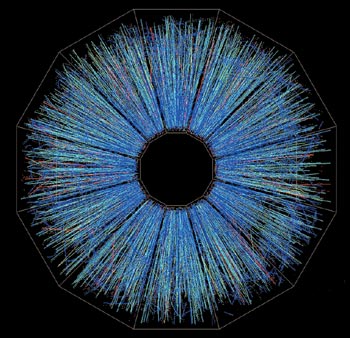First collisions at particle accelerators tend to be carefully managed public-relations exercises rather than scientifically important events, as Robert P Crease explains

First collision!
So ran many newspaper headlines worldwide two years ago, reporting on the initial operation of the Relativistic Heavy Ion Collider (RHIC) at the Brookhaven National Laboratory in the US. The stories were generally accompanied by a beautiful picture of particle tracks spewing outward from a point, like a wheel with thousands of thin, multicoloured spokes. But the first collision? Not exactly. And therein lies a tale.
First collision at RHIC
RHIC is designed to create head-on collisions between gold ions in two counter-revolving circular beams with a 4 km circumference. The beams intersect at six points, with detectors at four of these.
Early in 2000 the magnets of the superconducting rings were cooled down and the first ions injected. Beams made turns in the rings and their orbits were corrected. The beams were stored, captured by the radio-frequency system, and stabilized. They were accelerated from the 10 GeV injection energy to 70 GeV. They were “steered” so that bunches crossed each other in the same place, and “cogged” so that they crossed at the same time. They were “tuned”, or made to oscillate optimally. They were “beta-squeezed”, or shrunk in size to maximize the likelihood of collisions.
This was arduous, round-the-clock work. A breakthrough at each stage often meant having to fiddle with previous stages in a complex, nonlinear struggle to boost performance. But the lab management knew from bitter experience with a previous collider that delays can be embarrassing and even fatal. It was anxious to portray the commissioning as a supremely confident process in which Brookhaven’s scientists were en route to a finale as definitive as a rocket blast-off.
In May the New York Times quoted lab director John Marburger as saying: “When the time comes, [the operators] push a button, and there will be the first ion collisions.” Mocking scientists in the accelerator control room installed a large black button on the control panel labelled “COLLISIONS”, with wires that led conspicuously nowhere. “If that button really worked”, said one operator to me at the time, pointing to deep bags under his eyes, “we wouldn’t have these!”
By June the operators had the two beams counter-revolving simultaneously at injection energy. Some collisions were undoubtedly occurring at this point, but the detectors were not ready. Do collisions occur when no one sees them? Evidently not: the first collision would have to photographed.
On 12 June 2000 a clear-cut collision occurred in the STAR detector at about 9.00 p.m. When it showed up on the big plasma screen in the detector control room, everybody applauded. The log reads: “Champagne event.” But STAR’s magnets were not working – which is why the lines are not curved but straight – making particle identification impossible. The collision also took place at 30 GeV, not at full acceleration. But it was clearly in the intersection region, had some acceleration, and resembled a Monte Carlo simulation. It counted.
The next morning, a carefully worded press release referred to “the first spectacular images of particles streaming from a collision point” at STAR, and “high-energy collisions” at another detector. A three-minute video ran on a monitor in the lab cafeteria. But after grumblings from the other detector groups, a sentence was added to the release, saying that the other detectors “will soon begin collecting collision data as well” and the original video was replaced by one mentioning all four detectors.
First collisions elsewhere
But does this kind of stage-managing only happen at Brookhaven? The first big particle collider – CERN’s Intersecting Storage Rings (ISR) – was so daring that its creators worried more about achieving collisions between protons than recording them. Its initial detectors were inadequate even by contemporary standards and collisions were no doubt occurring long before they were detected in 1971.
When Fermilab near Chicago finished its proton-antiproton collider in 1985, only one of the detectors was ready. Internal politics did not therefore cloud the issue of which saw collisions first.
Four years later CERN turned on the Large Electron-Positron (LEP) collider, which had four detectors. The electron and positron beams were brought together on 11 August 1989, and some detectors saw collisions before others. However, the public relations were carefully stage-managed, and an announcement that all four detectors had seen collisions was made on 14 August, accompanied by a great party.
The first collisions at the HERA collider at DESY in Hamburg took place on 19 October 1991, as revealed by the luminosity monitors of one of its detectors. But scientific work could not begin for another year because of problems controlling the beam – precisely the kind of embarrassment that Brookhaven would later be anxious to avoid.
The critical point
The truly unprecedented event is rare, perhaps even non-existent; nearly always it is a case of repetition with a difference. First moments in science – as in other human endeavours – are often manufactured, defined by social and political forces.
So why does nobody object to the pretence? It is because of a happy intersection of the needs of different groups. Science administrators look for an excuse to show off a new programme. Politicians look for opportunities to appear at the birth of something important. Reporters seek a “hook” for a story and historians want a short-hand way of dating the appearance of something. Scientists, meanwhile – whose work mostly consists of lengthy preparations, calibrations and executions without significant landmarks – look for an excuse to pause and celebrate achievement.
The working practices, values and interests of these groups are usually so far apart that they are effectively quite different cultures. In this one artifice, these groups have finally found an opportunity that jointly satisfies their needs without requiring any group to compromise. This opportunity may well be a, ah, first.



